Welp, we had some rot. Specifically, the trim around one of our exterior windows was rotting away. How can you tell if window trim is rotting away? It feels like a sponge when you poke it. Wood is not supposed to resemble a sponge. Since winter is coming (don’t laugh, we have embarrassingly short summers!), Mrs. Frugalwoods and I are trying to knock out a few needed projects on the exterior of the ol’ Frugalwoods home and this rotted window trim quickly ascended to the top of the list.
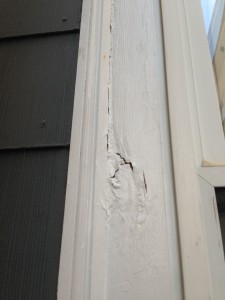
Our reasons for replacing it were not entirely cosmetic–rotten window trim can let water infiltrate behind your sheathing (the board, plywood, or OSB layer underneath your siding). If water gets to your sheathing, all sorts of bad things happen: mold, rotting insulation, and in the worst cases, rotting framing members.
We’re lucky because the window itself is a relatively new vinyl replacement window. Vinyl window are awesomely weather resistant so I knew we didn’t have actual window issues. If our windows were wooden frames, we’d likely have a bigger problem on our hands.
Fixing it isn’t rocket science, but the going local rate for this project is $350-$500. Knowing that this cost is almost entirely labor, we figured we could do better, and we did!
Total Cost: $80.33
Supplies:
- Tools:
- Drill / Driver for screwing the trim to the house. We needed to use screws instead of nails for this project due to the type of trim we were installing. And while a standard cordless drill will do fine for driving screws, an impact driver will freaking change your life. This is the one I have, since it uses the same battery packs as my drill. I put off this purchase for a long time and I kick myself for doing so.
- Pry bar for pulling apart the existing trim. For the longest time I resisted getting a real one, thinking that I could do just fine with the claws on a hammer. I was dumb. Pry bars are amazing and I now own 2 in different sizes. It makes pulling stuff apart easier, safer, and less likely to destroy things you don’t intend to destroy.
- Circular Saw for cutting the trim to size. You could use a miter saw, or even a hand saw. But, I have a circular saw so that’s what I used. This project doesn’t need a nice saw, so if you are in the market feel free to get an affordable model. I’d just recommend one that plugs in rather than taking expensive and short-lived batteries.
- Carpenter’s square for making straight lines. This is another tool that’s easy to ignore, but will make your life easier and more accurate. I have an old one from a garage sale (excellent source of tools!) but the standard stanley speed square is a great new option.
- Shop vac for cleaning the area during and after the build. Your neighbors and spouse will thank you. Wait for the cheap one to go on sale at home depot / lowes. Unless you are using one really heavily… they’re all pretty much the same. A handheld “dustbuster” can be used in a pinch, but clean it out well or you’ll be getting yelled at! 🙂
- Measuring tape for… I don’t need to explain this, right?
- Consumables:
- Cellular PVC trim. This stuff is magical. Looks like wood, cuts like wood, takes paint like wood… but it’s plastic so it won’t ever rot. This is what you want to use if you have to do trim work in wet areas. And if you’re replacing previous trim because of rot, then you definitely want this. It’s more expensive than normal poplar trim, but you’ll never have to do the job again.
- PVC compatible screws. PVC trim is great but you need special screws with reverse threads at the top to prevent it from mushrooming out when you drive it in. There are special trim screws for this, but we found the same thing for less marketed as decking screws for composite decks. Might as well save a few bucks here.
- Spray Foam. There is a special kind made for windows and doors that won’t expand with enough force to bind the window. The “Great Stuff” brand is ubiquitous and just fine.
- Flashing. I used a flexible and sticky asphalt flashing commonly known as “Ice and Water Shield.” It’s sold in big rolls for roofs but you can also find smaller rolls meant for windows.
- Caulk. You want exterior UV-rated paintable silicone caulk. The folks in the paint aisle can point you in the right direction from the multitude of caulk tubes. If this is your first time using caulk, you’ll also need a caulk gun. Don’t worry, they are cheap and sold near the caulk.
How To Replace Exterior Window Trim
Step 1: Demo!
Demolition is my favorite part of any home improvement project. Nothing like bashing things with hammers to make me smile! For this project through, you’ll want to be gentle.
First try and figure out which trim sections are rotten. Our window had both a flat board (sometimes called a “brick mold”) as well as a decorative molding. I originally thought it was only the brick mold that was rotten, but it turns out the molding was also getting soft in spots. Poke around with a screwdriver and you’ll quickly note which components are in need of repair. If it feels like wood, great! If it feels rubbery or spongy… then it’s time to tear it out!
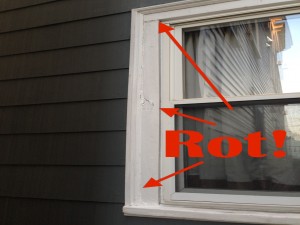
Once you’ve determined which components need to go, use a small pry bar to start removing the pieces. Your goal is to expose enough of the boards to get accurate measurements. Once you can clearly see what’s where, take a photo and measure the dimensions. If you can keep the trim pieces from falling apart as you demo, it will make cutting your new pieces to fit all that much easier.
Now finish removing all trim boards and pray to the god of old houses that you don’t find additional rot as you delve deeper into your wall. If you do find rotten sheathing or even framing… then you have bigger problems. Not insurmountable, but also maybe not a weekend project. If that’s the case, then you should go find another how-to post 🙂
Step 2: Shop
Now that you know the quantity and size of trim boards necessary, head to your local home store and make a beeline for the construction supplies. Here’s a pro-tip: Most of the pros are pretty nice. If you are confused, ask the guy in the filthy shirt with giant bulging muscles for advice. Dude will almost always hook you up. In our case it was a very nice Eastern European gentleman with forearms the size of cantaloupes who explained the finer details between brands of cellular PVC trim.
Step 3: Insulate
It’s time to inspect and insulate around the window. If you have a house built in the last 50 years, it won’t look like this. Modern houses use plywood or OSB (oriented strand board) as their sheathing. Besides being cheap, strong, and not requiring the destruction of old growth forests, OSB and plywood also make for very tight window installs.
Old houses like ours have board sheathing. In addition to being expensive, weak, and requiring the wide-scale deforestation of most of the United States, board sheathing tends to be poorly fitted around windows. Case in point:
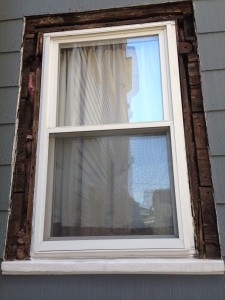
There’s probably a better way to do this, but wow do I love spray foam. The stuff is magical, especially for filling giant irregular voids.
Four extremely important things to know about spray foam:
- Wear latex gloves! This stuff is uber sticky. Like interior of a hot marshmallow sticky. And it’s not good for your skin. And you are almost certain to get it all over your hands. Wear some gloves and you’ll thank me later.
- Make sure the area you’ll be foaming is clean. Foam will stick to anything, including the layer of dust and dirt that likely resides around your window. A shop vac makes short work of this.
- After it’s applied, it continues foaming and expanding. So make sure you lay down a thinner layer than you need and let it expand to fill. You can always add some more on the second pass.
- Once you break the seal and pull the trigger on the can of foam there’s no stopping. You can’t re-use a can of spray foam and it starts to harden in the tube after about 15 minutes. Sooner if you don’t spray for a few moments. You have to keep moving and spraying if you want to get your money’s worth out of the can.
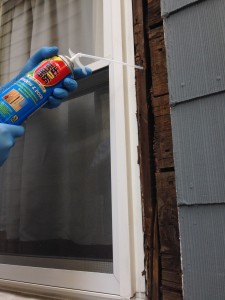
So have a plan! Move quickly and evenly apply a light layer of foam wherever your voids are deepest. Keep working your way around the window filling cracks, voids, holes, and whatever else gets in your way. In our case, we had giant voids to fill. If you have a newer home you might only have the area immediately adjacent to the window frame to insulate. In either case, insulation is worth the money while you have the window opened up. Might as well do it right.
After you’ve foamed all there is to be foamed (plus some stuff that probably shouldn’t have been, but you know how it goes…) take a break while the foam hardens. It should be fine to continue working after 20 minutes or so.
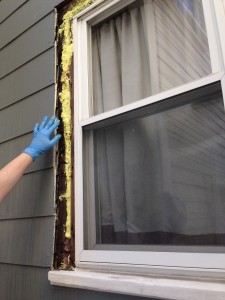
Step 4: Flash that window!
If your house was built correctly, you won’t need to do this step as you’ll already have flashing. As for us, we needed it.
Flashing a window is a way to seal the area around the window from water infiltration while allowing any water that gets behind the trim boards to exit the wall structure. You can use all manner of materials as flashing: plastic, aluminum, lead (yes, and it works great!). We chose a flexible, sticky asphalt product commonly know in the trade as “Ice and Water Guard.”
This stuff is really easy to use. Just cut your pieces to size, peel the backing paper off, and stick it up.
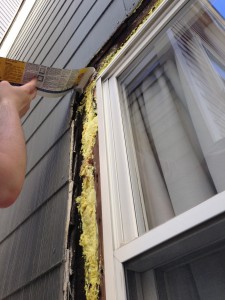
You’ll want to apply the various pieces around the window from bottom to top. That is, you want water to be able to travel down the face of the flashing and never find an overlapped seam facing upwards. For the top strip of flashing, try to get it as far underneath the layer of siding above as possible. For the flashing on the sides, try to end the flashing on top of the bottom course of siding. This sounds great in theory, but reality can prevent it from being perfect. Just try the best you can.
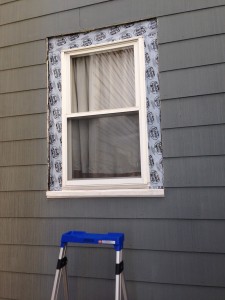
Step 5: Measure and cut trim boards
Now measure for your trim and cut. I like working from the top down, but I have no idea if that’s actually better.
Our old brick mold wasn’t mitered in the corners so I followed the pattern and butt jointed it. Yes, I just said butt joint. It’s a carpenter’s term, for real. To cut a straight line with a chop saw or miter saw is simple. If you are making the cut with a circular saw, draw a straight line on the board with a carpenter’s square to make sure you don’t wander. Don’t be a cowboy, you and I both know you can’t eyeball it.
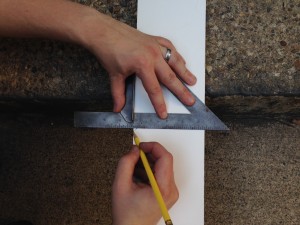
While the left side and top of the window was a dead ringer for 1×5, the right side was juuuust too small for me to wedge it in there. Oh the joys of old houses! So I scribed the 1×5 to match the variation in the siding edge and ripped it with the circular saw. This I did mostly eyeball because I knew I would be covering the crappy edge with the decorative molding. Screw the boards in place with your nifty special screws (they are actually pretty neat) and step back and admire how much more like a window it looks already!
Step 6: Miter your decorative molding
Unlike your trim board brick mold, decorative molding is pretty ugly in the corners unless you cut it on a 45 degree angle–aka a miter joint.
When faced with cutting a miter joint, normal folks would go out and buy a miter saw. This makes it really easy to cut perfect miters every time, but will run you a couple hundred dollars.
If you are like me and a member of team “if it can’t be done with a circular saw then you shouldn’t be doing it,” then read on. Cutting a 45 degree miter is not much harder than a 90 degree straight cut. The trick is getting a good line in place, and for that the carpenter’s square is essential. Measure carefully to the outside of the miter (the longest part) and check your marks twice before cutting. It’s really easy to get confused and draw your 45 degree line in the wrong direction (ask me how I know this…).
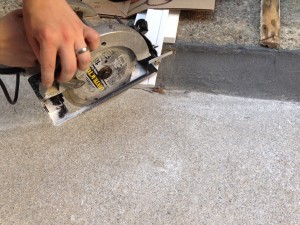
Once you have your line in place, carefully follow it with your circular saw. If you go slowly and check your measurements, no one will ever know you didn’t use a miter saw. Now screw in your molding and admire your handiwork!
Step 7: Caulk
Oh you thought you were finished? Not quite. Break out the caulk and run a bead on all of the joints. Smooth each joint with a moist finger (no joke, the best way to get a good caulk line). Don’t forget to add a dab of caulk to each screw hole as well.
Once the caulk is dry you can decide whether you want to paint. So far we haven’t, because the new white trim matches our existing trim pretty well.
Step 8: Victory!
Now you are actually done. Bask in the glory of saving hundred of dollars. Revel in the new confidence you built in your DIY skills. Or just take a shower. You probably need a shower real bad by now.
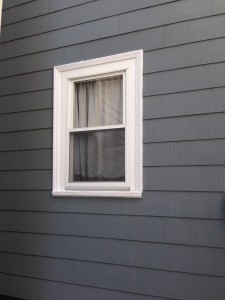
Why do all this?
We’re focused on building (hah!) a sustainable life, both from a skills-learning perspective AND from a stable financial perspective.
Our immediate goal is to “retire” early to a homestead in Vermont and leave our city jobs behind.
As part of that plan, we’ve embarked on a journey of radical (sometimes hilarious) frugality. Sometimes it’s trimming a window, other times it’s cutting my wife’s hair at home (way scarier for me than window trim!)
Want to know more? Check out our About page to investigate the radical frugality journey so far.
Hope your own window trim project goes well! Feel free to ask questions in the comments — we still read and respond to them even though this post is nearly a year old.


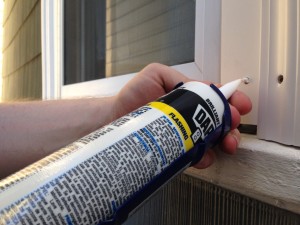

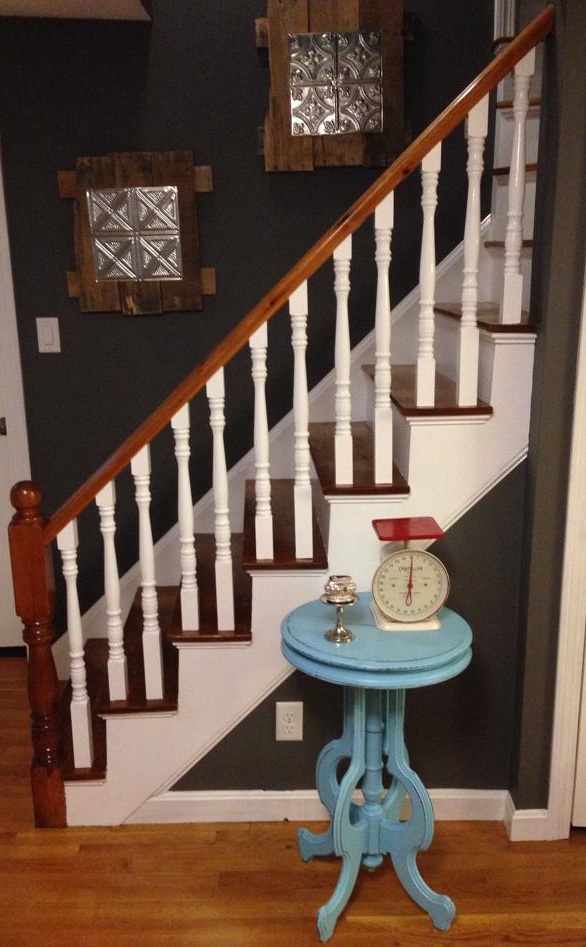




Although I do not have a window trim to replace, I do have a door trim to replace. So this is basically perfect timing as much of what is required for me to do will be the same as what you did for the window! I will be bookmarking this page for that project, that’s for sure!
Oh cool, glad you found it useful! Your door should in theory be framed much the same way as a window, so other than slightly more material it should be a cinch. Good luck, let us know how it turns out!
Note to other readers:
Spray foam is an awesome product, but is also the stickiest substance on earth. Once on clothes, you will NEVER get it off. Just like roaches, this stuff will survive a nuclear attack.
Similar to eating pizza or BBQ, I can’t use spray foam without getting it all over myself. Wear your worst shirt and pants.
This man is not joking. Another thing to watch out for that I should have mentioned in the post is to make sure you have a drop cloth in place beneath the area that you are spray foaming. We didn’t originally, but as I started to see some drip Mrs. FW ran to get our drop cloth and saved the concrete walkway.
I managed to not get any on my clothes, but I did get some in my arm hair which took several days worth of showers to get out.
But there is something about spraying foam that is tremendously fun. It’s like using a water pistol, except you are shooting out almost-exploding goo! I’ve used a pro setup on a past job that has a permanent tube and bigger, more powerful cans. I felt like the draft-terminator! Habitat for Humanity FTW!
I agree, totally fun! Kind of like being the person who gets to work the hose when blowing insulation into the attic. Loading the hopper? Not so much fun.
I’ve never blown in insulation, but it sounds fun. Something tells me it’s an itchy job!
True. Spray foam gets everywhere. But ACETONE will completely destroy it before it hardens.
DIY Tip: When using hardware store chemicals, always read the cleanup instructions. Buy the solvent needed when you’re buying the goopy goo!
For spray foam, nail polish remover works in a pinch, but often has moisturizers added. Just buy the quart/liter sized tank of pure acetone. Because if, like me, you’re incapable of being careful enough, acetone, and lots of it, will save the day. Or save the pants/ siding/ carpet/ sidewalk. It can even be used to clean out the applicator and spray nozzle so you can reuse a partial can. Unless the foam has set up, then it’s game over.
… what’s a measuring tape?
I kid, I kid! I do a lot of automotive DIY projects. Up next may be rust repair…
Um, writeup please? The much loved frugalwoods-mobile has more than a bit of body rust after nearly 20 years in cold climates. I’ve always been interested in learning body work, it seems like it’s as much an art as science to make it look nice! Good luck!
Evaporust. Followed with Mr Clean magic eraser or a never-touched-rust wire brush to remove the black.
These are awesome tips and steps. We have not done a window project; however, we recently re-tiled and installed a new toilet in our bathroom. We lost a few tiles along the way of figuring out the tile cutter, but overall, we are really happy with the results and it saved us a ton of money!
Super impressed you did a bathroom! We need to re-grout the tile around our tub, and patch the enamel on said tub, but I think that’s a winter project. In Boston we have to prioritize projects that require outdoor operations for our somewhat short summer. The winter project list is starting to pile up after several months of putting them off!
It looks great! That’s a really nice step by step of the process. We do a lot of DIY projects at home, most recently we built a backyard corn hole game set.
Thanks! A corn hole set is something that’s on my long term to-do list. It seemed like every get together we ever went to in the midwest had one but I don’t see it that often here in Boston. We don’t have grass, but our neighbor’s back yard would be perfect… Hmm. Now you have me thinking! Did you emblazon it with your university colors?
Awesome work! You guys are handy dandy and great photos to back up your post! The savings is super duper too!
Thanks! The credit for the photos goes to the magnificent Mrs. Frugalwoods. She manages to document these projects while simultaneously doing at least 50% of the work! It’s a team effort around here!
Except for Frugal Hound. She’s not allowed within 50 feet of a circular saw 🙂
Great tutorial. I am ashamed at how not-handy I am. But I think it’s because I just have never really tried. I’m pretty good at new things, so maybe I’ll get around to this stuff when I’m back at my rental.
Glad you liked it!
Usually home repair isn’t nearly as complicated as it first seems. And there really are very few expensive mistakes you can make. For the most part, if you get stuck or something goes wrong, having a handyman fix it and finish the job is no more expensive than if you had hired them in the first place. So you might as well give it a try! At least that’s the logic I use when I’m psyching myself up to tear a hole in the wall 🙂
Thank you so much for this thorough and well-written post! We live in an older house, so I always worry a bit about what we’ll do when this stuff comes up.
I’m so glad you found it interesting!
It does seem that with old houses there is always a maintenance backlog! Cross one project off the list an another rears its head!
You’re after my own heart! I love that you talk about OSB and specifics, not just “the wood underneath.” Excellent accuracy, Mrs.Frugalwoods!
This is a great tutorial. So many projects are totally doable, you just need to venture forth!
Thanks! It’s true that just “getting started” is half the battle. It’s intimidating but so worth it in the end. And then you get to look at your accomplishments every day! Thanks for stopping by!
Agreed. Thanks for mentioning specific product/material options. I’m currently moving/adding 7 windows in my fixer upper from the ’40s. All my sheathing around them looks like yours. Longer term I need to put flashing on all the windows that didn’t move/change. Which means I may as well re-trim them, so I appreciate the tip on the PVC that won’t rot. Good thing I just picked up a few boxes of composite decking screws at the HfH ReStore.
Wow this is super useful! I just bookmarked this page as this is a project I’ll definitely have to tackle within the next few years.
Oh good! Hope it’s helpful!
Another thing to add for my DIY list. We don’t have a guy in the house, I pretty much do everything around the house and I’m too frugal to pay for something like this as well..so thanks a lot for this!
You are most welcome, I hope it’s helpful! Thanks for stopping by, glad to have you here 🙂
I’m doing this today. The painter is coming tomorrow to pressure wash and paint. I had a person called to repair the wood but as happens so often in the south it fell through. So I’m doing it myself. Why? With a cold and rain threatening. Because of my HOA, do not get me started. Got any ideas about how to do house trim above the fascia?
Hey Kathleen! Sorry I didn’t see this until today, I hope your work was successful! I’m afraid I don’t really have tips for trim above the fascia anyway though, other than the obvious “a nail gun is going to make that so much easier”. I’ve done that trim work on a new house (Habitat for Humanity) and it was unfairly easy thanks to scaffolding. I’m sure it’d be much more of a bear on the ladder. Probably would need two people (and two ladders) to handle the long stock.
This was very helpful. Thanks so much.
Is vinyl the best material to use to last long and prevent any patch work in the future? I have an old house that is getting more and more rotted wood. I want to replace all the windows with a better material and be done with it for good!!!! lol
Vinyl is a great material for the actual window. For the trim, cellular PVC (what I used above) will certainly hold up well long term. If you need to go with wood (for HOA, etc…) then cypress trim is supposed to be very rot resistant. Not common up in New England though.
Frugal tip: cans of spray foam are reusable! Remove the application straw immediately after you apply the spray foam. Spray a pipe cleaner with WD-40 and pass it though the straw to clean it out. Use the WD-40 and pipe cleaner combo to clean the nozzle as well. Once everything is clean you can reattach the straw and reuse the can at a later date.
The front of my house has a brick exterior and 4 normal sized rectangle windows (about 3 ft wide by 5 feet tall). The opening of the brick front is much larger vertically, so below each window is a square (about 3 ft by 3 ft) piece of white wood with a trim around it. That wood and trim is rotting out and needs to be replaced. This seems easy to do, I was just looking for some advice before I start. What is that bottom piece of the window/wood called anyway?
This diy is exactly what I was looking for! Some friends helped install new vinyl windows for my house, but never installed trim. I was looking at getting the windows capped, but its expensive. This looks like something I can handle so I’m ready to try it. 🙂
I was just told by an “expert” that our exterior frame could not be fixed even though it has slipped down and has a couple of spots that will not even be connected after they “fix”it. We love the door or would just replace it. The issue is that we live in AK and with the earthquakes and extreme temperature changes it can be damaging even to the best made material. Suggestions? He honestly tried to tell me the the window and frame were all one piece before I pointed out to him that the trim was coming off in one spot. I would love to let them come and do what you want the finish work for the guarantee, but don’t want something that looks like arse.
Great tutorial! I have an older home (not old enough to have that “character”, just old enough to have “popcorn ceilings” etc.). There are so many things i am redoing and only so much money, so I have to pick and choose. Granite, i cannot do by myself. Replacing rotted trim, I can! Thanks to you!!!!
Love your writing style. Informative and entertaining. We are buying a house next month which we need to trim and seal a bathroom window.. guessing from.the 50s. This post will come in handy. 🙂
The exterior wood trim on my garage door needs replacing but at the bottom there is a space that lets allot of water into the garage. The space doesn’t appear to be from rotted wood, it somehow seems to be that the house itself wasn’t made to connect to the floor. Can u help?
Confused about the fire and ice tape… this is applied over the top and directly onto the hardened foam spray?
I like how you sad that demolition is the best part of any home project. We are thinking of replacing our downstairs windows this spring. Thanks for the tips on how to replace exterior windows.
Great article, but better things than expanding foam ? There are many reason it is called “Great Stuff” … Not even sliced bread is better !! You could, in theory, restart the can if you put the tip on that little peg on the top of the trigger. When it is cured later, you cut that part of the tube and could use again (that’s how it’s described on the Great Stuff can) but realistically, in one can there is so little amount that it is barely enough for one window with large gaps.. and for $5 bucks, I guess a project like this can afford $50 bucks of spray foam, even if like my old house, there’s potential for 10 windows.
The demolition is not the best part… the best part is when you say, “Done, it looks great !!!’
My carpenter put in 3/4 thick instead of 7/4 thick trim It does not match thickness of above trim. He said this was ok. I don’t like it and see it is indented. Will water get behind? Width and length is ok.
That’s a good idea to use a moist finger to smooth out the caulk. I could see how your finger would be the right shape to correctly smooth it out. I’ll make sure to try that out when I am applying caulk in the future to see if it gets a better result than the spoon I use currently.
A friend of mine owned a rental that was destroyed by the renters .and vacated right about the time he was job transferring out of state. He was devastated because he did not have time to do all the work needed to rent it out again. He would loose too much if he sold it as is. I had been looking for a bigger place and this one was the perfect size . So I offered to take on the task and do the repairs. But not for free rent. That’s just silly and I don’t know why anyone would expect such a thing. Landlords still have property taxes and bank notes. He wanted nothing above that. His reward was that he could now move on to his new job , but another house in that state to live in and still keep this one..
I am a female. At that time i was about 40 years old, single and very resourceful. I had many good friends in construction and remodeling so I had no problem acquiring materials. I just needed to learn how to do the work myself. I can tell you this, if you really want to do something, you will do it. There is a world of knowledge out there, and people like you that are willing to share and advise. Thank you for that. I learned everything from sheet rock to plumbing, carpet laying, to window installing, fence building to concrete work. ( I love tile work)
My landlord friend was in town one day and came to visit. The first thing he said was that he had drove right passed the house twice and was beginning to think he was on the wrong street because he did not recognize the house!
Sorry to keep rambling on but I want to say one more thing. Some of my friends simply could not understand why I would put my time and my own money into something I didn’t even own. The answer is easy. Weather you own the home or not, it’s where you live. Why wouldn’t you want it to look nice and function well? And with rent as high as it is , I would still be saving a bundle even if I spent five hundred dollars a month at the hardware store. The bank note : $450.00 per month. The home: a 3 br. 2 ba, 2 car garage, brick with large rooms Vaulted 20′ ceiling, 2 separate attics you could stand up in, central air & heat on a 1/4 acre lot. My education: priceless.
Thank you! This is exactly the tutorial I’ve been searching for. So many others involve new construction and creating a new window hole etc. This is perfect for my 1920’s house with new windows and sketchy aluminum clad trim.
I have found that brake cleaner spray does a nice job of cleaning up foam goofs!